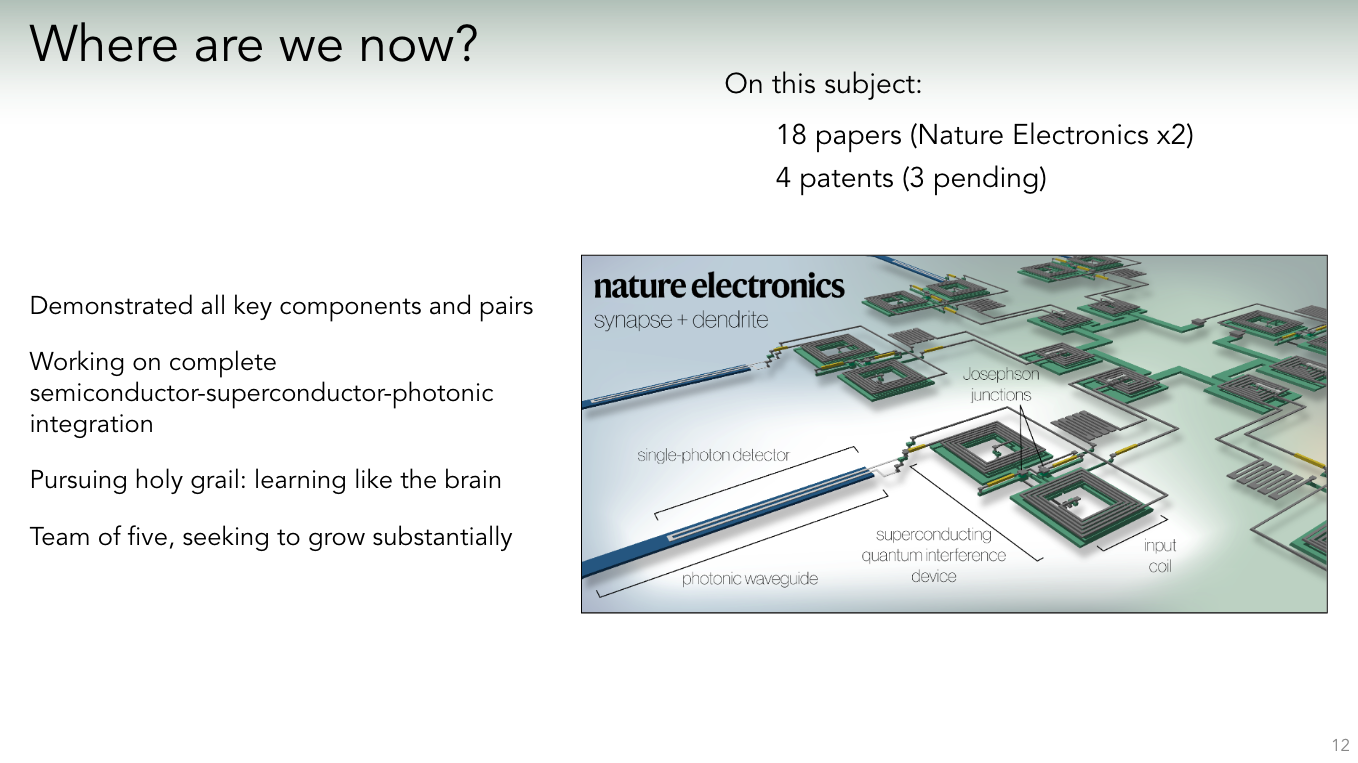
A Focused Research Organization for Superconducting Optoelectronic Intelligence
Artificial intelligence places strenuous demands on current computing hardware, but the integration of semiconductors, superconductors, and optical hardware will create revolutionary new tools for AI.
Digital computers are excellent for number crunching, but their operations and architecture contrast with the operations that support intelligence. When used for AI, vast amounts of energy, data, and time are required to train new models. Meanwhile, the field of computational neuroscience relies on these digital computers to simulate cognition. Because the underlying computational hardware is poorly matched to the operations of synapses, dendrites, and neurons, the same problems with time and energy arise. We can address both these needs with advances in computer hardware.
Project Concept
We can address both these needs with advances in computer hardware. Our approach builds upon the silicon transistors of digital computing, adding superconducting circuitry to accomplish neural computations, and optical components to realize extensive communication across human-brain-scale systems. We have already made substantial progress in demonstrating key components and are ready to scale to a multiyear effort to integrate into a chip-scale cortex (see slides).

You can learn more about superconducting optoelectronic networks in this slide deck.
What is a Focused Research Organization?
Focused Research Organizations (FROs) are time-limited mission-focused research teams organized like a startup to tackle a specific mid-scale science or technology challenge. FRO projects seek to produce transformative new tools, technologies, processes, or datasets that serve as public goods, creating new capabilities for the research community with the goal of accelerating scientific and technological progress more broadly. Crucially, FRO projects are those that often fall between the cracks left by existing research funding sources due to conflicting incentives, processes, mission, or culture. There are likely a large range of possible project concepts for which agencies could leverage FRO-style entities to achieve their mission and advance scientific progress.
This project is suited for a FRO-style approach because the integration of semiconductors, superconductors, and optical hardware is beyond the scope of a single academic or government research group, and this endeavor will require appreciable investment in a well-orchestrated, focused team, more akin to a startup. However, given the complexity of the technology, five years will be required to bring a competitive product to market, which is still too early for venture capitalists. Because AI hardware is well-established and continuously improving, gaining market traction will require not only superior hardware, but also streamlined software and user interfaces. An FRO is the ideal context to pursue a complete system meeting the needs of a large and diverse pool of users.
How This Project Will Benefit Scientific Progress
By realizing superconducting optoelectronic networks, we will achieve cognitive AI with vastly more computational power than has been possible with the largest supercomputing clusters of today, while consuming only a fraction of their power. Continued scaling of our technology will not come at the cost of environmental harm. Scientists, engineers, and entrepreneurs across the country will have access to a revolutionary new tool to interpret and analyze complex, multi-modal datasets. This form of advanced AI will change how we provide health care, harness energy, model Earth’s climate, and more. Superconducting optoelectronic hardware will usher the largest transition in computation since silicon, enabling powerful tools for computing and an experimental testbed to elucidate the mechanisms of our own minds.
Key Contacts
Author
- Dr. Jeffrey Shainline, NIST, jeffrey.shainline@nist.gov
Referrers
- Alice Wu, Federation of American Scientists, awu@fas.org
Learn more about FROs, and see our full library of FRO project proposals here.
At a time when universities are already facing intense pressure to re-envision their role in the S&T ecosystem, we encourage NSF to ensure that the ambitious research acceleration remains compatible with their expertise.
FAS CEO Daniel Correa recently spoke with Adam Marblestone and Sam Rodriques, former FAS fellows who developed the idea for FROs and advocated for their use in a 2020 policy memo.
When the U.S. government funds the establishment of a platform for testing hundreds of behavioral interventions on a large diverse population, we will start to better understand the interventions that will have an efficient and lasting impact on health behavior.
Integrating AI tools into healthcare has an immense amount of potential to improve patient outcomes, streamline clinical workflows, and reduce errors and bias.